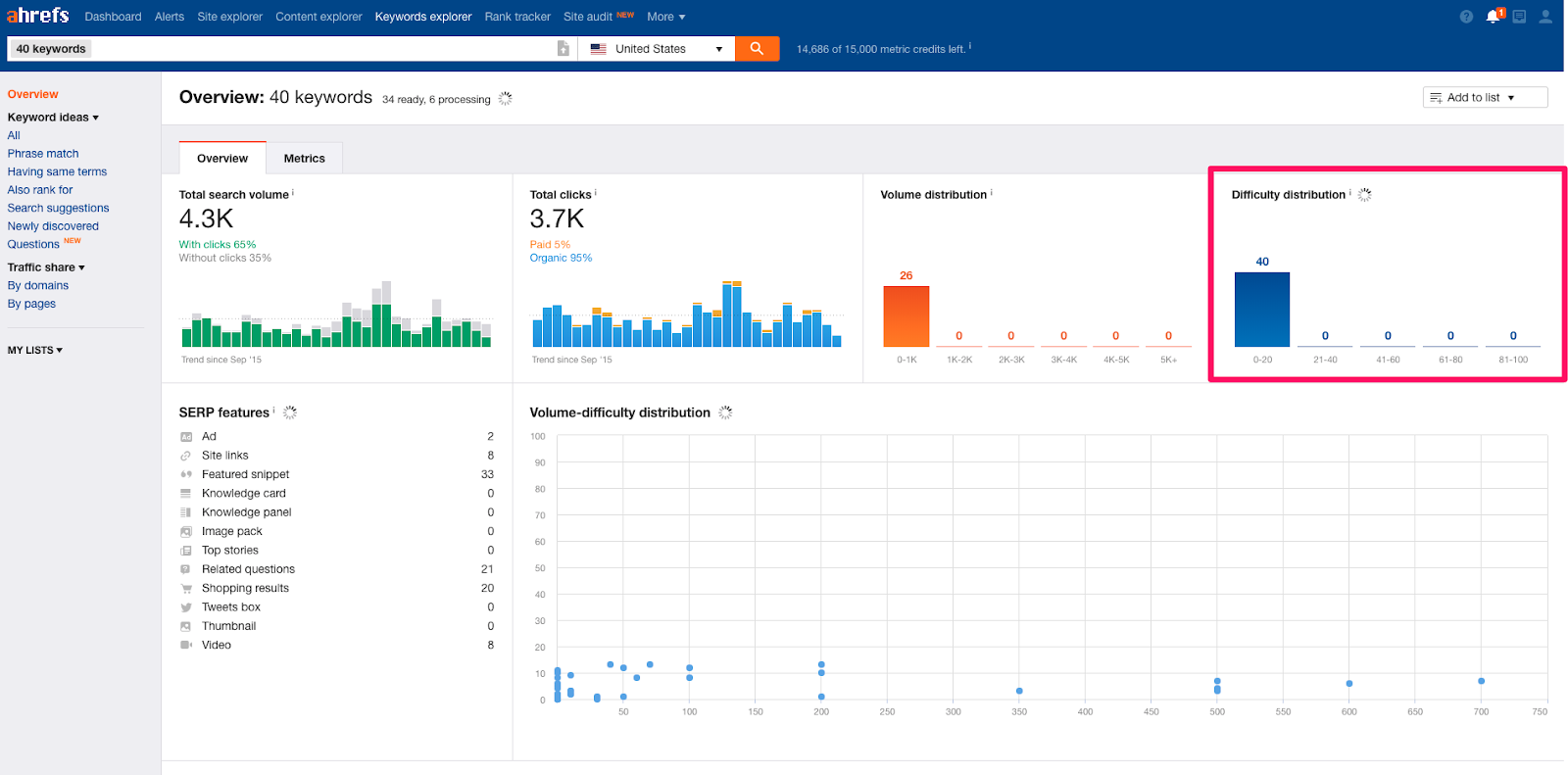3 Steps to Understanding if Your Blog Has SEO Potential
The first question we have to ask when a new client reaches out about having us take over their content marketing is:
“Is there an SEO opportunity here?”
It would be great if every site were equally capable of growing through organic search, but they aren’t. No matter how hard you try, you’re not going to get millions of monthly organic visitors to your blog about hedgehog sweaters.

Sometimes, the answer isn’t so obvious though. You might strongly believe the area you’re passionate about has hundreds of thousands of other people looking for information on it, but when you launch your blog… crickets.
Or, you might be sitting on an organic traffic goldmine that you don’t even know about.
Either way, the first step to figuring out the best content strategy for a blog is to explore the SEO potential. Can this topic bring in over 100,000 monthly readers organically through Google? Or will you have to focus on other channels like social media?
We use a simple three-step process to determine whether or not a topic area has a high SEO potential. You can use it to figure out if you should be focusing on search for your own blog, or to determine if SEO could work for a new blog you’re considering starting.
The process consists of three phases:
- Brainstorming the Content
- Checking the Data
- Assessing the Competition
Let’s dive in.
Step 1: Brainstorming the Content
The first question you have to ask is: Are there enough topics I can think of for an SEO-focused blog to make sense?
SEO is a long game that requires a substantial number of articles to be worthwhile.
As a general rule, if you can’t come up with 100 content topics for your niche in an hour or two, it’s probably not broad enough.
That may sound like a lot, but there are a couple content brainstorming strategies that can help with this immensely.
Brainstorming Strategy #1: Scorch the Earth
For your niche, ask yourself if there’s a way you can create a huge amount of content by “scorching the earth” on a certain topic.
Let’s look at an example of a business doing this well. If you Google “Slack and Google Sheets integration,” here’s what comes up first:

And if you Google “Basecamp Asana integration,” you get:

Zapier, the tool for automating interactions between webapps, shows up first for both of these results, as well as hundreds of other searches from people looking for integrations between different webapps.
The pages follow a simple formula and don’t require a ton of writing, which lets Zapier create one for every single possible interaction between their 500-plus webapps (making 250,000 possible pages).
Each individual page may not bring in a ton of traffic, but if each one brings in even 10 people per day, that can add up pretty quickly.
We’ve started doing this with our reviews pages on Cup & Leaf. Each review only takes a few minutes for us to put together, but over time, we have the potential to rank for every single tea that we review. Someone looking for the Capital Teas Milk Oolong could click on our review instead of Capital Teas’ page.
Each individual tea review might not bring in a ton of traffic, but together, they add up to a huge stream of organic searches. And we can make a page for every single tea we ever try, making the total amount of content potential limitless.
This is also something I’ve done with my book notes. Most book notes only bring in 10 to 20 visitors a day, but since I have over 200 of them, they add up to about 1,388 extra visitors per day:

Is there a topic like tea reviews, app integrations, or book notes where you have a near limitless supply of relevant content ideas? If you do, then you have a great foundation for an SEO-focused content strategy.
Brainstorming Strategy #2: Content Formulas
You might not have a good scorch the earth option for your site. No problem, content formulas are another way to quickly come up with a ton of ideas for potential search-focused content.
This is as simple as asking yourself: Are there any article types that I could repeat for a bunch of different variations?
For example, let’s imagine a photography blog. Since there are so many different lenses and camera types, it’s easy to come up with content formulas you can use to generate tons of article ideas:
- How to shoot great portraits with [X lens / camera]
- Best camera for [X situation]
- Best lens for [X situation]
- How to shoot [X event]
- How to get hired for [X photography job]
If you want to get fancy, you can create a spreadsheet to help you do this. It will help make the next section go faster, so I’d recommend it if you want to go the content formula route.
Simply create one column on the left of all the X’s you need for a given formula. In this case, let’s take situations. (Here’s a link to the spreadsheet if you want it.)

Then add columns for each formula you want to apply those situations to:

Now, you can add a formula to combine the two phrases together to make your article topics:

That formula is: =CONCATENATE($C$1,” “,A2)
Then you just apply that formula to all the cells below it and create similar formulas for the columns to the right, and you’ll have a ton of new article topics!

That only took a few minutes to think up, but I already have 40 topics for my prospective photography blog.
Before moving on to the second step in assessing your SEO potential, make sure you were able to fairly easily come up with a huge number of potential topics. If you struggled to come up with over 100, then SEO might not be the strategy for you.
But if you were able to come up with that big initial list, then it’s time to move on to the next step.
Step 2: Checking the Data
Now you need to figure out if those ideas are actually getting looked for, if they’re bringing in traffic, and if they won’t be too hard to compete on.
For this, you’ll need an SEO tool to help you out.
I typically recommend one of two tools:
- Ahrefs if you want a full-featured, high-powered keyword research tool
- Mangools if you want something lighter and cheaper
Either will work fine, but I’ll be using Ahrefs for this demonstration.
The easiest way to quickly assess if your content ideas have legs is to copy and paste everything you came up with in step one. If you didn’t use a spreadsheet or write down all of your scorch the earth ideas, then go do that now.
Once you have your big list of initial keywords, go to the Ahrefs Keywords Explorer and simply copy them all in:

You’ll see an overview of the results. The first thing you want to look at is the volume distribution:

In this case, the volume isn’t great. They’re all below 1,000, which means they won’t drive a ton of traffic even if we get on the first page for them.
The second question is difficulty, which you can see right next to the volume:

The difficulty for these terms is great because it’s really low, so at least they aren’t hard to rank for. But based on how low-volume the terms are, I’d say these keywords aren’t worth writing content for.
Now, compare those photography keywords to these cryptocurrency ones:

There are many more keywords in the high-volume range, but not many more in the high difficulty range. Cryptocurrency topics are getting searched for significantly more, but they aren’t that much harder to rank for. This is a high-potential topic area for an SEO-focused blog.
Here’s the last thing you want to check: Go to the “Metrics” tab and look at the little green bar by each keyword:

The green bar tells you what percentage of searches for that term result in clicks. If the green bar is closer to the left, then very few people are clicking through on search results —maybe because Google is giving them an answer box that solves their question for them.
But if your volume is high, difficulty is low, and click-through rate is good, then you’re ready to move on to the final step.
Finer Points
Okay, I know you’re now wondering: What exact volume, difficulty, and click-through rate are you looking for?
There’s no hard answer, but if 80 percent of your keywords have over 500 volume, less than 40 difficulty and 75 percent click-through rate, you’re in great shape.
This doesn’t apply if you have an exceptionally high customer value and don’t need as many visitors to your content. In that case, you might be fine with as low as 50 to 100 volume per article.
Step 3: Assessing the Competition
If you were able to come up with a bunch of topics easily and their numbers came out fine in Ahrefs, then you’re likely in great shape for focusing on SEO for your site.
But to be safe, it doesn’t hurt to quickly assess the competition.
All you need to do for this step is go to Google and plug in some of the keywords you’re thinking of writing about and see what comes up.
For the photography site, maybe we’d plug in “best lens for landscape photography”:

It’s hard to tell from the outside if these are any good, so I’d have to read through them and see what I’m competing with.
For other keywords, it might be more obvious. If I search “how to lose weight,” the top results are all from fairly well-known and high authority sites, and I wouldn’t want to compete with them.

But if I search for a keyword and Google serves up results from Reddit, Pinterest, forums, WikiHow and other major content aggregators, it’s a strong indicator that it’ll be easy to rank for that keyword. Those are the kinds of results to be on the lookout for.
Otherwise, as long as the content doesn’t look too intimidating and your results from the first two steps were good, you should have a strong indicator that your site can be competitive for search traffic.







